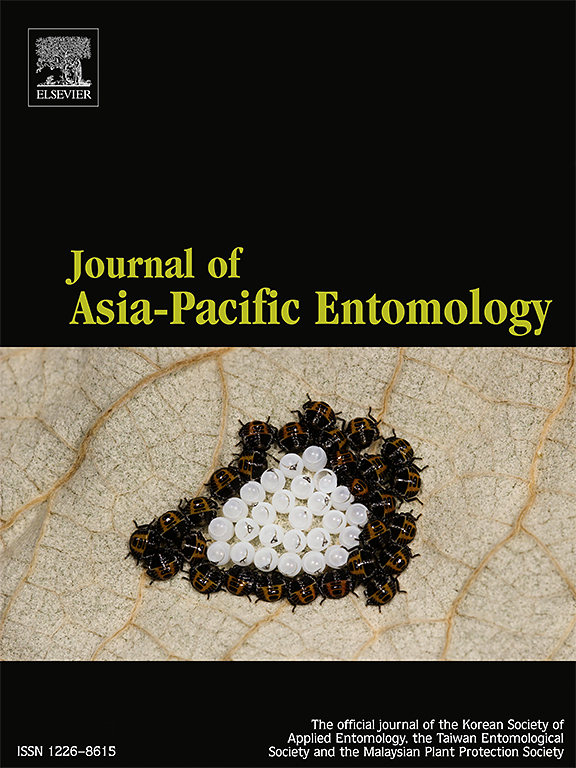由天然糖和黄花菊培育的能量蔗对甘蔗螟虫害虫的抗性机理
IF 1.3
3区 农林科学
Q3 ENTOMOLOGY
引用次数: 0
摘要
对以自发糖(Saccharum spontanum)为直系亲本的I型和以圆叶菊(Erianthus arundinaceus)为直系亲本的II型新选育的26株能源甘蔗进行了抗甘蔗早梢螟虫(ESB)、甘蔗螟(Chilo infuscatellus)和节间螟虫(INB)、甘蔗螟(Chilo sacchariphagus indicus)的抗性筛选。田间和实验室筛选研究结果表明,与天然能量藤相比,环棘能量藤中ESB和INB的发病率要低得多,对节间形态没有明显的损害。此外,II型能量藤饲喂的ESB和INB通过降低其幼虫和蛹的存活率而对其生长发育产生不利影响。ⅰ型和ⅱ型能量藤的ESB和INB幼虫期分别为22 ~ 34 d和39 ~ 52 d。次生代谢产物如酚类物质、硅含量、多酚氧化酶和蛋白酶抑制剂含量显著增加,阳性营养物质含量显著减少,表明了黄花蒿耐药的机制。此外,与棘豆相比,棘豆PIs能有效抑制ESB和INB的中肠蛋白酶。蛋白酶抑制剂、硅和酚含量与甘蔗螟虫的发病率和发育呈显著负相关。该研究鉴定出3种耐螟虫的II型能源甘蔗(SBIEC 14006、SBIEC 11004、SBIEC 11001)和1种可用于生物燃料生产的I型甘蔗(SBIEC 13010)。此外,这些优良无性系可以作为未来能源甘蔗育种计划中开发耐螟虫品种的遗传资源。本文章由计算机程序翻译,如有差异,请以英文原文为准。

Resistance mechanism of energy canes developed from Saccharum spontaenum and Erianthus arundinaceus against sugarcane borer pests
A total of 26 newly developed energy canes including Type I having Saccharum spontaneum as immediate parent and Type II having as immediate parent Erianthus arundinaceus were screened for resistance against sugarcane early shoot borer (ESB), Chilo infuscatellus and internode borer (INB), Chilo sacchariphagus indicus. Field and lab screening study results indicated that ESB and INB incidence was much lower in E. arundinaceus energy canes, with no discernible impairment to internode morphology than in S. spontaneum energy canes. Furthermore, Type II energy canes-fed ESB and INB showed adverse effects on growth and development by reducing their larval and pupal survivability. Besides, ESB and INB larval durations were 22 to 34 days and 39 to 52 days in Type I and Type II energy canes, respectively. A significant increase in secondary metabolites, such as phenols, silicon content, polyphenol oxidase and proteinase inhibitors, as well as a decrease in positive nutritive compounds in E. arundinaceus, indicated the antibiosis mechanism of resistance. Furthermore, E. arundinaceus PIs effectively inhibited the midgut proteases of ESB and INB compared to S. spontaneum PIs. Proteinase inhibitors, silicon and phenolic content showed a significant negative correlation with the incidence and development of sugarcane borers. The study identified three borer-tolerant Type II energy canes (SBIEC 14006, SBIEC 11004, SBIEC 11001) and one Type I cane (SBIEC 13010), which could be utilized for biofuel production. In addition, these elite clones can serve as genetic stocks for developing borer-tolerant varieties in future energy cane breeding programmes.
求助全文
通过发布文献求助,成功后即可免费获取论文全文。
去求助
来源期刊

Journal of Asia-pacific Entomology
Agricultural and Biological Sciences-Insect Science
CiteScore
2.70
自引率
6.70%
发文量
152
审稿时长
69 days
期刊介绍:
The journal publishes original research papers, review articles and short communications in the basic and applied area concerning insects, mites or other arthropods and nematodes of economic importance in agriculture, forestry, industry, human and animal health, and natural resource and environment management, and is the official journal of the Korean Society of Applied Entomology and the Taiwan Entomological Society.
 求助内容:
求助内容: 应助结果提醒方式:
应助结果提醒方式:


